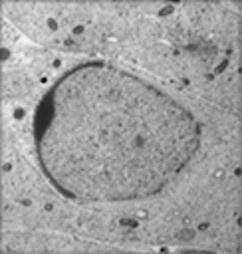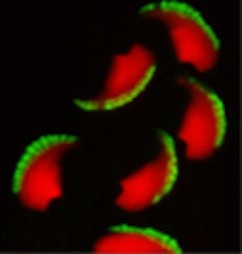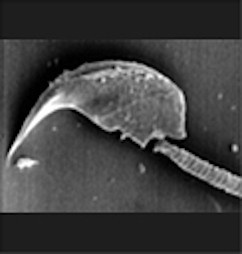Aarnoud C. van der Spoel
Assistant Professor

Email: spoela@dal.ca
Phone: 902-494-7084
Mailing Address:
Clinical Research Centre
PO Box 15000
Halifax, Nova Scotia, Canada B3H 4R2
- Curriculum vitae 2017 [PDF - 63 kB]
Education
- MSc, University of Utrecht, Utrecht
- PhD, Erasmus University, Rotterdam
Academic Positions
- Department member since 2009
Research Topics
Biochemistry and cell biology of inherited neurodegenerative diseases. Intracellular traffic of proteins and glycosphingolipids.
Research
Lipids
A typical cell contains over 1000 structurally distinct lipid species, making up about one-third of its dry mass. It is a major challenge to understand the physiological and pathological roles of the many lipid species.
Glycosphingolipids
My research focuses on one class of lipids, sphingolipids - in particular glycosphingolipids (GSLs), which are composite molecules made up of the sphingolipid ceramide and a mono- or oligosaccharide. A striking feature of the GSL family itself is the multitude (over 300) of structural variants, differing in their ceramide and carbohydrate domains. A typical mammalian cell contains a number of distinct GSLs, in different amounts, depending on cell type, developmental stage and other factors.
Glycosphingolipids in health and disease
GSLs are important in biology and medicine. These two-domain molecules are ubiquitous membrane components, and play essential roles in embryonal development, the functioning of the central nervous system, the establishment of skin impermeability, spermatogenesis, and are involved in Type 2 diabetes, Alzheimer's disease, autoimmune neuropathies, bacterial infections, atherosclerosis, and genetic metabolic disorders.
Beta-glucosidase 2 (GBA2): drug target in lysosomal diseases
Glucosylceramide is a simple glycosphingolipid: it is made up of ceramide and glucose. Glucosylceramide is synthesized at the cis-Golgi, and can be degraded by either glucocerebrosidase (in lysosomes) or by beta-glucosidase 2 (GBA2) at the plasma membrane/endoplasmic reticulum. We have recently redefined the enzyme activity of GBA2, and developed a new approach to measure GBA2 activity. The previous method for determining GBA2 activity systematically under-estimated the enzyme's activity. Using our new method for measuring GBA2 activity, we found that GBA2 is more sensitive to inhibition by the drug miglustat (Zavesca(R)) than previously thought. Miglustat is a small-molecular compound structurally similar to glucose, but miglustat is an iminosugar, having a cyclic nitrogen instead of an oxygen; miglustat also carries a butyl group linked to the ring nitrogen, it is thus an alkylated imino sugar. Because of its structural similarity to glucose, miglustat can inhibit a number of enzymes involved in glycoconjugate and glycan metabolism. Importantly, the various enzyme targets of miglustat differ considerably in their sensitivity to inhibition by this drug. Miglustat is clinically licensed for type 1 Gaucher disease and Niemann-Pick type C disease in over 45 countries. Mouse models for these two genetic diseases display many of the pathological features of human patients. Type 1 Gaucher disease and Niemann-Pick type C disease are both lysosomal storage disorders, but differ considerably in their pathologies; the former affects primarily the mononuclear phagocyte system in the liver, spleen and bone marrow, while the latter has a progressive neurodegenerative course with central nervous system inflammation. Significantly, it has been shown that ablation of the Gba2 gene reduces disease severity in the mouse models for type 1 Gaucher disease and Niemann-Pick type C disease! These results suggest that inhibition of GBA2 by miglustat may contribute to the therapeutic benefits seen in type 1 Gaucher disease and Niemann-Pick type C patients.
Beta-glucosidase 2 (GBA2): mutated in genetic disease
During the course of 2013, and early 2014, four papers were published identifying mutations in GBA2 in patients affected with a combination of cerebellar ataxia and spastic paraplegia (referred to as SPastic Gait locus #46, SPG46). First symptoms of this condition were diagnosed early in life (median age 7, range 1-20), and disease manifestations include muscle weakness and spasticity in upper and lower limbs, ataxia, axonal neuropathy, cognitive impairment, thin corpus callosum, and cerebellar and cerebral atrophy. At present, no adequate therapies are available for SPG46 or for most other forms of hereditary ataxias and paraplegias. We are studying the consequences of the mutations found in the GBA2 gene, in particular at the biochemical level. We have established that the nonsense and missense GBA2 mutants have no catalytic activity, and that some of these mutants are expressed at a very low level. SPG46 patients thus share a deficit in GBA2 enzyme activity, which is likely the biochemical basis of their pathology.
Keywords:
Genetic metabolic disease, HPLC, organelle formation, glycosphingolipids, mouse genomics
Current Lab Members
| Nagendra Thillaiappan | Former MSc student at the University of Oxford |
|---|---|
| Charlotte Walden | Former DPhil student at the University of Oxford |
| Madison Zuverink | Postdoc (Medical College of Wisconsin) (co-supervised with K. V. Ewart) |
Publications
- Sultana S, Truong NY, Vieira D, Wigger JGD, Forrester AM, Veinotte CJ, Berman JN, van der Spoel AC (2016). Characterization of the Zebrafish Homolog of beta-Glucosidase 2: A Target of the Drug Miglustat. Zebrafish 13: 177-187.
- Sultana S, Reichbauer J, Schüle R, Mochel F, Synofzik M, and van der Spoel AC. Lack of enzyme activity in GBA2 mutants associated with hereditary spastic paraplegia/cerebellar ataxia (SPG46). Biochem Biophys Res Com 465: 35- 40. (2015)
- Ridley CM, Thur KE, Shanahan J, Thillaiappan NB, Shen A, Uhl K, Walden CM, Rahim AA, Waddington SN, Platt FM, van der Spoel AC. Beta-glucosidase 2 (GBA2) activity and imino sugar pharmacology. J Biol Chem 288, 26052-26066 (2013).
- Platt FM, Boland B, and van der Spoel AC. Lysosomal storage disorders: the cellular impact of lysosomal dysfunction. [Review series: The Cell Biology of Disease] The Journal of Cell Biology, 199: 723-734 (2012).
- Oko R, Donald A, Xu W, and van der Spoel AC. Fusion Failure of Dense-core Proacrosomal Vesicles in an Inducible Mouse Model of Male Infertility. Cell Tissue Res. 346: 119-34 (2011).
- van der Spoel AC, Mott R and Platt FM: Pharmacogenetics in mice — Differential sensitivity of mouse strains to an N- alkylated imino sugar: glycosphingolipid metabolism and acrosome formation. Pharmacogenetics, 9: 717-31 (2008).
- Elliot-Smith E, Speak AO, Lloyd-Evans E, Smith DA, van der Spoel AC, Jeyakumar M, Butters TD, Dwek RA, D’Azzo A and Platt FM. Beneficial effects of substrate reduction therapy in a mouse model of GM1 gangliosidosis. Mol Genet Metabol, 94: 204-11 (2008).
- Rabionet M, van der Spoel AC, Chuang CC, von Tümpling-Radosta B, Litjens M, Bouwmeester D, Hellbusch CC, Körner C, Wiegandt H, Gorgas K, Platt FM, Gröne HJ, and Sandhoff R. Male germ cells require polyenoic sphingolipids with complex glycosylation for completion of meiosis: A link to ceramide synthase-3. J Biol Chem, 283: 13357-13369 (2008).
- Walden CM, Sandhoff R, Chuang CC, Yildiz Y, Butters TD, Dwek RA, Platt FM, van der Spoel AC: Accumulation of Glucosylceramide in Murine Testis, Caused by Inhibition of beta-Glucosidase 2: IMPLICATIONS FOR SPERMATOGENESIS. J Biol Chem, 282: 32655-32664 (2007).
- Alexander C Wu, Peter Sutovsky, Wei Xu, Aarnoud C van der Spoel, Frances M Platt and Richard J. Oko. The Postacrosomal Assembly of Sperm Head Protein, PAWP, is Independent of Acrosome Formation and Dependent on Microtubular Manchette Transport. Developmental Biology, 312: 471-83 (2007).
- Giovanni D’Angelo, Elena Polishchuk, Giuseppe Di Tullio, Michele Santoro, Antonella Di Campli, Gun West, Chia-Chen Chuang, Aarnoud C. van der Spoel, Anna Godi, Frances M Platt, Yusuf Hannun, Roman Polishchuk, Peter Mattjus, and Maria Antonietta De Matteis. Non-vesicular transport of glucosylceramide via FAPP2 is required for glycosphingolipid synthesis and membrane transport to the plasma membrane. Nature, 449: 62-67 (2007).
- Charlotte M. Walden, Terry Butters, Raymond A. Dwek, Frances Platt and Aarnoud C. van der Spoel. Long-Term Non- Hormonal Male Contraception in Mice Using N-Butyldeoxynojirimycin. Human Reproduction 21: 1309–1315 (2006).
- Van der Spoel, A. C., Jeyakumar, M., Butters, T. D., Charlton, H. M., Moore, H. D., Dwek, R. A. and Platt, F. M. Reversible infertility in male mice following oral administration of alkylated imino sugars: a non-hormonal approach to male contraception. PNAS 99: 17173-17178 (2002).
- Van der Spoel, A., Bonten, E. and d'Azzo, A. Processing of lysosomal b-galactosidase. The C-terminal precursor fragment is an essential domain of the mature enzyme. J Biol Chem 275, 10035-10040 (2000).
- Van der Spoel, A., Bonten, E. and d'Azzo, A. Transport of human lysosomal neuraminidase to mature lysosomes requires protective protein/cathepsin A. Embo J 17, 1588-1597 (1998).
- Bonten, E., van der Spoel, A., Fornerod, M., Grosveld, G. and d'Azzo, A. Characterization of human lysosomal neuraminidase defines the molecular basis of the metabolic storage disorder sialidosis. Genes & Dev 10, 3156-3169 (1996).




